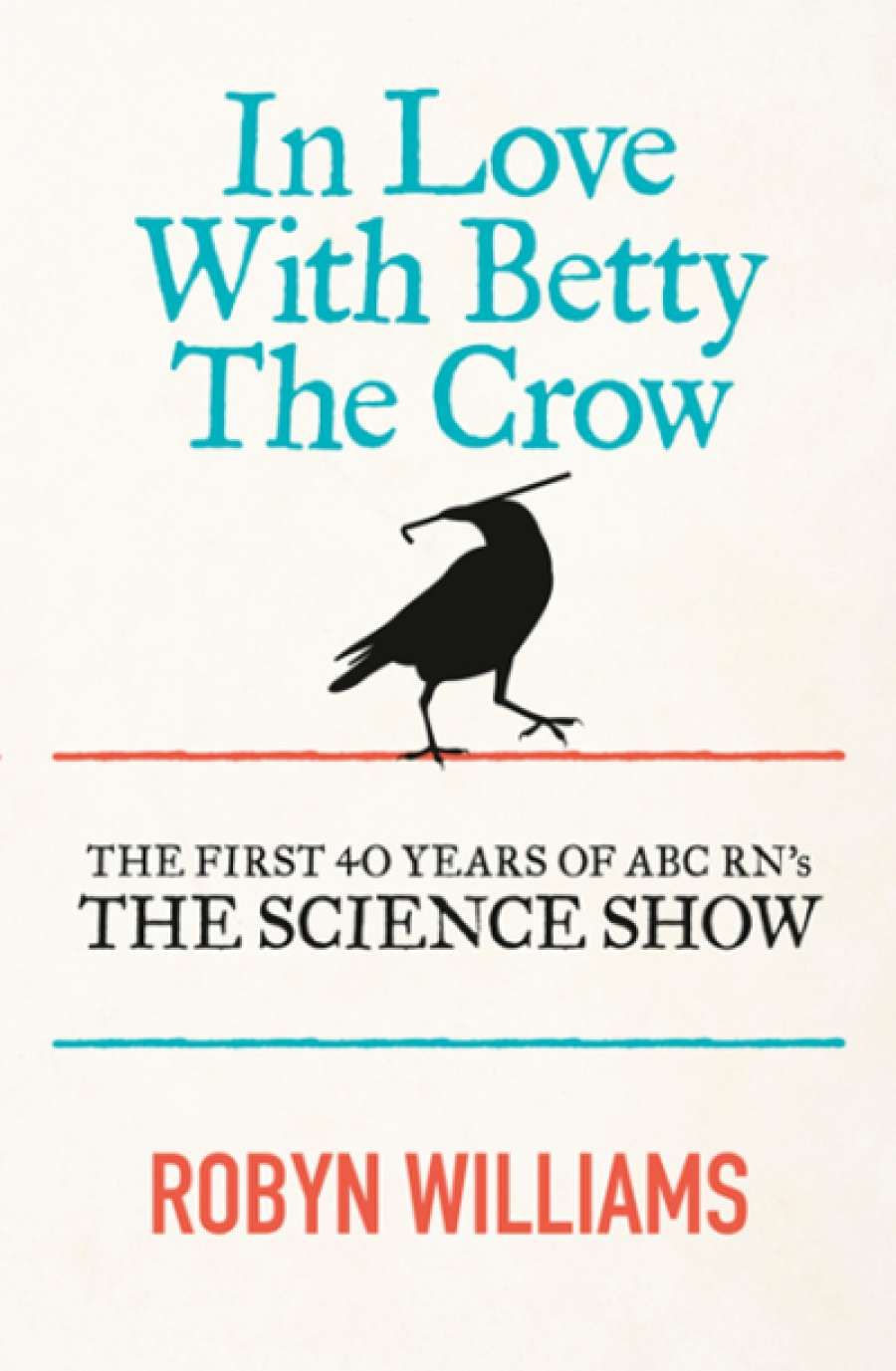
- Free Article: No
- Contents Category: Science and Technology
- Custom Article Title: Ashley Hay reviews 'In Love with Betty the Crow: The first 40 years of ABC RN's 'The Science Show'' by Robyn Williams
- Book 1 Title: IN LOVE WITH BETTY THE CROW
- Book 1 Subtitle: THE FIRST 40 YEARS OF ABC RN’S THE SCIENCE SHOW
- Book 1 Biblio: $32.99 pb, 288 pp, 9780733335013
In Love With Betty the Crow combines Williams's reminiscences of the life of this flagship radio program with others he has worked on under the auspices of the ABC's now diminished Science Unit (stayers, such as Ockham's Razor, and others, such as Investigations), interspersed with stories from his own life (like his appearances in iconic British productions such as Monty Python's Flying Circus and The Goodies) and beyond. It weaves his meditations on different facets of Australia's life in science with transcripts extracted from the broadcasts themselves. There are occasional lists, including twelve areas of research that look particularly promising for Australia's future and a chapter delineating some of the people Williams believes comprise Australia's A-team (from entire institutions such as the Walter and Eliza Hall Institute in Melbourne and the University of Tasmania's Department of Chemistry, to Nobel Laureate Peter Doherty and our newly designated Chief Scientist, Alan Finkel).
 Robyn Williams (photograph by Barrylb, via Wikimedia Commons)I was finishing In Love With Betty the Crow as the World Science Festival decamped from its usual New York home to the Queensland Museum in Brisbane (attracting thousands of attendees) and ABC-TV's Q&A featured five erudite, respectful scientists instead of its regular cohort. Everywhere I turned people were talking science, thinking science, asking questions about science. (As one viewer commented via the Q&A twitter feed: '"We're really missing the politicians tonight," said no-one.') This made me think about the purpose and scope of Williams's enterprise – not just in these pages but in the four decades ('involving 14,280 stories ... 1836 hours of continuous broadcasting') of work through which they spelunk.
Robyn Williams (photograph by Barrylb, via Wikimedia Commons)I was finishing In Love With Betty the Crow as the World Science Festival decamped from its usual New York home to the Queensland Museum in Brisbane (attracting thousands of attendees) and ABC-TV's Q&A featured five erudite, respectful scientists instead of its regular cohort. Everywhere I turned people were talking science, thinking science, asking questions about science. (As one viewer commented via the Q&A twitter feed: '"We're really missing the politicians tonight," said no-one.') This made me think about the purpose and scope of Williams's enterprise – not just in these pages but in the four decades ('involving 14,280 stories ... 1836 hours of continuous broadcasting') of work through which they spelunk.
The Science Show would not exist without the scientists, who range from illustrious and emeritus figures to PhD students. But it's not a show for them, rather one for all the non-scientists. At its core is a constantly vivifying discussion of new things – things made, things discovered, things explained, things debunked; a kind of discursive twist on the idea of 'citizen science' – science for citizens, if you like.
Williams has spent four decades conversing with an enormous number of people about their fascinating and critical work. His weekly radio hour (now also available via podcast, which, combined with All in the Mind, attracted more than seven million downloads last year) injects listeners' conversation with snippets of information about everything from 3D-printed muscles and nerves (at the University of Wollongong) to the fact that magpies purr (according to researchers at the University of New England), or the extraordinary Betty, the book's eponymous bird, who fashioned a hook from a straight piece of wire to access some food left in a pipe when an experiment ended (in Oxford).
Williams has other concerns in these pages. There are some incidents with which he would like to take issue; some decisions he would like to explain. He is also interested in the intersections between journalism and science: the words 'scientist' (1833) and 'journalist' (1830) 'born so closely together ... I like to feel there has been some synergy between them: truth'. He wants to celebrate how much you can fit into all those hours of radio – and to boast a bit. 'We try to keep you informed on the main set of ideas currently coming from top-line research ... And we can obtain almost anyone you care to name: being forty means you know the crowd and even caught Brian Cox when he was a boy and not booked up like an opera singer.'
You leave Williams's book as you leave an episode of The Science Show: informed, entertained, challenged, and with the sense that you have witnessed an elegant and effortless dance, under-pinned by all the work of planning and craft as much as a necessary kind of polymathy. In casting around for a word to define this book and all its parts – mélange? miscellany? a kind of taster-plate of audio history? – I thought of teleidoscopes, the lesser-known relatives of kaleidoscopes, whose many lenses refract and reshape pieces of the real world into an infinite variety of patterns. These scopes were once called 'philosophical instruments'. Both The Science Show and this account of it might snuggle under that label too. Not really deified, of course, but extraordinarily constant and long-lived.


Comments powered by CComment